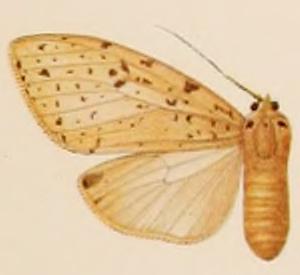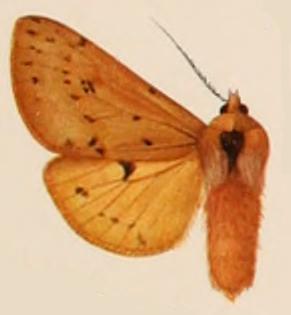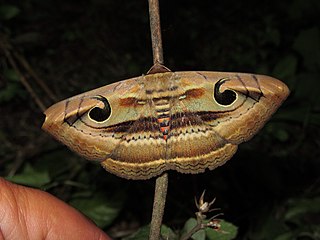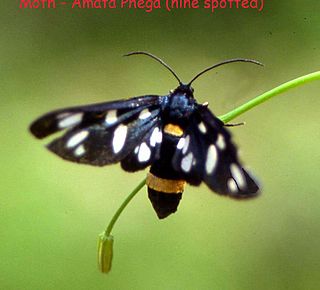
Acherontia styx, the lesser death's head hawkmoth or bee robber, is a sphingid moth found in Asia, one of the three species of death's-head hawkmoth. It is very fond of honey, and bee keepers have reported finding dead moths in their hives as a result of bee stings. They can mimic the scent of bees so that they can enter a hive unharmed to get honey. Their tongue, which is stout and very strong, enables them to pierce the wax cells of the beehive and suck the honey out. They are also known to be a pest of yuzu in South Korea, using their tongue to pierce and damage the fruit.

Lyclene is a genus of lichen moths of the family Erebidae, subfamily Arctiinae. The genus was erected by Frederic Moore in 1860.

Nepita is a monotypic moth genus in the subfamily Arctiinae erected by Frederic Moore in 1860. Its only species, Nepita conferta, the footman moth, was first described by Francis Walker in 1854. It is found in India and Sri Lanka.

Asota is a genus of moths in the family Erebidae first described by Jacob Hübner in 1819. Species are widely distributed throughout Africa, India, Sri Lanka, Myanmar, the Malayan region and tropical parts of the Australian region.

Eudocima materna, the dot-underwing moth, is a moth of the family Erebidae found in widespread parts of the world, mainly in tropical Asia extending to New Guinea and Australia as well as in Africa. Reports from the United States, Canada and the French Antilles are now considered to be Eudocima apta. The species can be differentiated from other Eudocima moths by the presence of small central black dot in each hindwing. The species was first described by Carl Linnaeus in his 1767 12th edition of Systema Naturae.

Argina astrea, the crotalaria podborer, is a moth of the family Erebidae. The species was first described by Dru Drury in 1773. It is found in eastern Africa, southern Asia of India, Sri Lanka, and Indo-Australia, including the Pacific Islands and Australia.

Lophocampa albescens is a moth of the family Erebidae. It was described by Walter Rothschild in 1909. It is found in French Guiana, Suriname and Venezuela.

Spilosoma alberti is a moth of the family Erebidae. It was described by Walter Rothschild in 1914. It is found on Papua New Guinea, where it is restricted to mountainous areas at high altitudes ranging from 1,200 to 2,150 meters.

Spilosoma fraterna is a moth of the family Erebidae first described by Walter Rothschild in 1910. It is found on Papua New Guinea.

Spirama retorta, the Indian owlet-moth, is a moth of the family Erebidae. The species was first described by Carl Alexander Clerck in 1764. It is found in China, Korea, Japan (Honshu), India, Nepal, Bangladesh, Thailand, Cambodia, Myanmar, Vietnam, Taiwan, Sri Lanka, Malaysia, the Philippines (Luzon), Indonesia ,Japan.

Lophocampa sullivani is a moth in the family Erebidae. It is found in Ecuador (Pichincha) and Colombia.
Asura varians is a moth of the family Erebidae. It is found in Sri Lanka.

Eressa confinis is a moth of the family Erebidae. It was described by Francis Walker in 1854. It is found in India, Bhutan, Sri Lanka, Myanmar, Taiwan and China.
Lemyra subfascia is a moth of the family Erebidae. It was described by Francis Walker in 1855. It is found in Sri Lanka.
Lophocampa dinora is a moth of the family Erebidae. It was described by William Schaus in 1924. It is found in Argentina and Bolivia.
Padenia transversa is a moth of the subfamily Arctiinae. It was described by Francis Walker in 1854. It is found in Sri Lanka and on the Andamans.

Spilosoma latiradiata is a moth in the family Erebidae. It was described by George Hampson in 1901. It is found in South Africa and Zambia.

The Syntomini are a tribe of moths in the family Erebidae. The tribe was erected by Gottlieb August Wilhelm Herrich-Schäffer in 1846.
Barsine defecta is a moth of the family Erebidae first described by Francis Walker in 1854. It is found in Sri Lanka, Nepal, Thailand and Vietnam. It is the type species of genus Barsine.

Cyana bianca is a moth species in the subfamily Arctiinae and tribe Lithosiini. It is found from India to Indochina and consists of a species complex.















